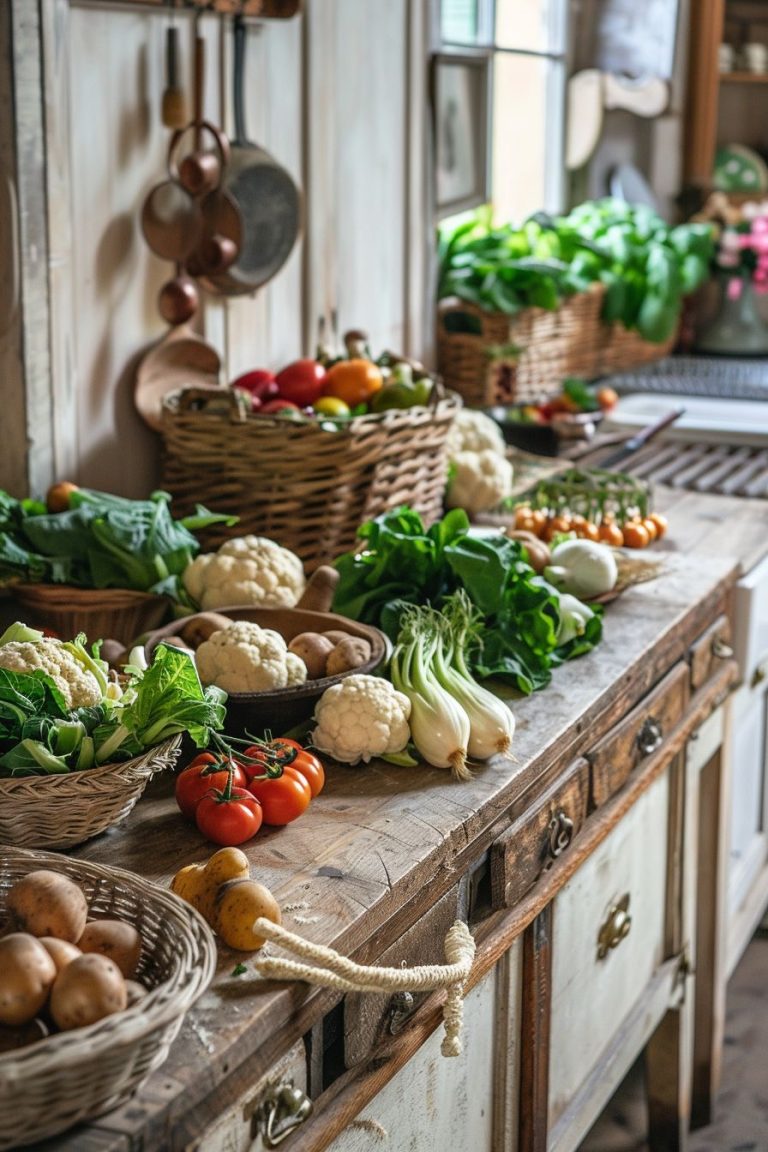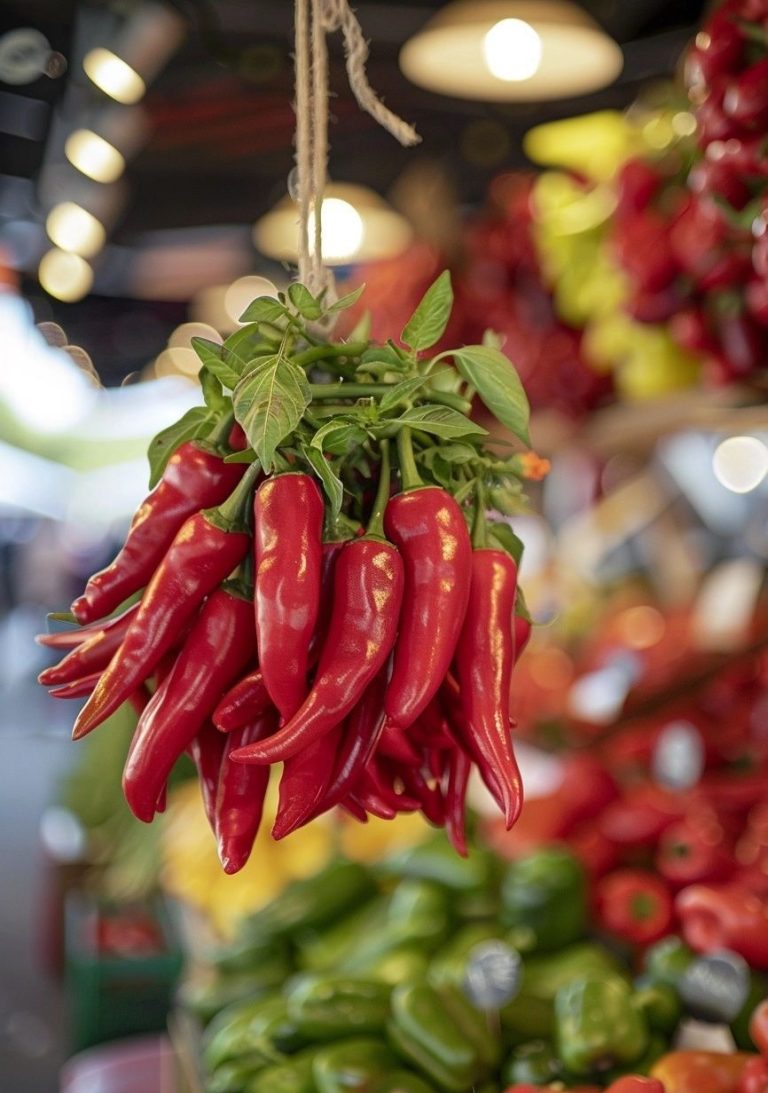9 Types of Vegetables Commonly Used in French Recipes
We may earn a commission through all links on this website. As an Amazon Associate, we earn from qualifying purchases.Bonjour, mes amies! It’s time to venture into the vibrant heart of French cuisine – the humble, yet extraordinary world of vegetables. We all know and adore French food for its luxurious pastries, creamy cheeses, and ethereal sauces, but today we’ll explore another pillar that lends French cuisine its unique soul – les légumes!
France’s deep appreciation for fresh, local produce is almost unrivaled, with each region boasting its signature veggies, each one full of life, color, and flavor. And it’s these vegetables, often plucked straight from local markets or backyard gardens, that form the vibrant green backdrop on the canvas of French cuisine.
Whether it’s the crunchy, sweet radishes of Île-de-France, the luscious tomatoes of Provence, or the robust leeks of Brittany, French cuisine is as diverse as the vegetables that grace its lands. These sun-kissed offerings of Mother Earth are more than mere ingredients; they are the keystones of French gastronomy.
But you don’t need to jet off to the French countryside or queue at a Parisian marché to appreciate these vegetables. With a little guidance and a spirit of culinary adventure, you can bring these authentic flavors right into your own kitchen.
So, strap on your aprons and join me on a delightful journey through the alluring world of French vegetables. Whether you’re an ambitious gourmand or a simple lover of nature’s bounty, I promise this gastronomic journey will leave you with a newfound admiration for these earthy treasures that shape the panorama of French cuisine.
From traditional preparations to modern renditions, let’s learn about France’s favorite vegetables – their history, regional preferences, and how they are used to create the beloved dishes we all savor.
Here are the different vegetable classifications eaten by the French. These vegetables have been grouped according to which part of the plant is consumed.
Bon appétit!

Leafy Vegetables
These French vegetables are usually consumed by eating their leaves.
Lettuce
Lettuce, specifically the crisp, sweet Batavia variety, is a staple in French salads and sandwiches, prized for its fresh crunch and subtle taste.
Mesclun
A true jewel of the Côte d’Azur, mesclun is a diverse blend of young, tender salad greens, a flavorful mix that makes the perfect base for a traditional French salad.
Mâche
Mâche, also known as lamb’s lettuce, is a winter favorite in French markets, celebrated for its soft texture and nutty flavor, and is typically served in salads or as a delightful garnish.
Arugula
Arugula, or roquette as the French call it, is cherished for its peppery punch, and it’s not uncommon to find this bold green in a salad, atop a pizza, or nestled within a baguette sandwich in France.
Spinach
Beloved in France, spinach, or épinards, serves as the star in a multitude of dishes, from creamy soups and gratins to light salads and the famous quiche aux épinards.
Cabbage
Cabbage, in its many forms, plays a key role in hearty French dishes like choucroute garnie from Alsace, with each variety lending its unique flavor and texture to the culinary landscape.
Watercress
Watercress, or cresson, with its peppery zing, is often used in French cuisine to create refreshing salads, creamy soups, and elegant garnishes, adding a pop of flavor to any dish.
Endive
Endive, known as chicory in some parts of France, is revered for its crisp texture and slightly bitter taste, often braised to perfection or used raw in salads.
Brussels Sprouts
Brussels sprouts, or choux de Bruxelles, are enjoyed across France, roasted to a delightful caramelized finish, or shredded and sautéed, adding zest and texture to many dishes.
Seed Vegetables
These kinds of French vegetables are fleshy and often contain seeds.
Tomatoes
Tomatoes, particularly the juicy Marmande variety, are a summertime favorite in France, essential to classic Provençal dishes like ratatouille and salade niçoise.
Zucchini
Zucchini, or courgette, is a versatile vegetable in French cuisine, featured in an array of dishes from hearty gratins to savory tarts, and even used as a delightful stuffing for blossoms.
Eggplant
Eggplant, or aubergine, is a star ingredient in the south of France, its rich, smoky flavor lending depth to traditional dishes like ratatouille and moussaka.
Cucumber
Cucumbers, with their crisp texture and refreshing taste, are a staple in French salads and play a significant role in classics like vichyssoise, a chilled leek and cucumber soup.
Squash
Squash, including the round, sweet potimarron variety, is a cornerstone of French autumn cooking, used in everything from soups and stews to gratins and tarts.
Pumpkin
Pumpkin, or citrouille, is celebrated in French cuisine, particularly in the regions of Provence and Alsace, where it is used in savory pies, hearty soups, and even sweet preserves.
Peppers
Peppers, particularly the sweet, mild pimientos found in the Basque region, are used to add color, sweetness, and a hint of spice to various French dishes, from salads and stews to the famous piperade.
Root Vegetables
These French vegetables grow underground through a long root.
Carrots
Carrots, whether of the vibrant orange or the heirloom purple variety, are a kitchen staple in France, adding sweetness and color to dishes like boeuf bourguignon and pot-au-feu.
Beetroot
Beetroot, or betterave, is a cherished root vegetable in France, its earthy sweetness lending a delightful contrast in salads, and its vibrant hue makes it a stunning addition to any dish.
Radishes
Radishes, particularly the delicate, crunchy French Breakfast variety, are a quintessential snack in France, often enjoyed raw with a pat of butter and a sprinkle of flaky sea salt.
Turnips
Turnips, or navets, are a classic root vegetable in French cooking, starring in traditional dishes like pot-au-feu, or simply roasted for a side dish highlighting their subtle sweetness.
Tuber Vegetables
Tubers are also considered root vegetables, however, they have been enlarged to store nutrients. These French vegetables also produce food that grows underground on the root of a plant.
Potatoes
Potatoes, or pommes de terre, are a beloved staple in French cuisine, playing the starring role in dishes ranging from the creamy gratin dauphinois of the Rhône-Alpes region to the rustic and hearty tartiflette of the Savoie.
Yam
While not as commonly used as other vegetables, yams, also known as igname, are found in French tropical cuisine, particularly in the French Caribbean and Réunion Island, where they are baked, boiled, or made into gratins and stews.
Bulbous Vegetables
These types of French vegetables grow slightly below the surface of the ground and produce a leafy fruit above ground. Bulbs in this group often have many layers or come in clusters.
Leeks
Leeks, or poireaux, are a quintessential vegetable in French cooking, their sweet, mild flavor forming the basis of beloved dishes such as potage parmentier, a creamy leek, and potato soup.
Onions
Onions, whether the sweet rosé de Roscoff or the piquant Cévennes variety, are fundamental to French cuisine. They lend their savory depth to classics from the rich onion soup to the delicate pissaladière.
Garlic
Garlic, or ail, is a cornerstone of French cuisine, its powerful aroma and taste-enhancing dishes across all regions, whether in the rustic chicken dish, poulet à la provençale, or the iconic garlic-infused mayonnaise, aioli.
Shallots
Shallots, with their delicate flavor that blends the sweetness of onions with the punch of garlic, are a favorite in French cooking, used extensively to add depth to sauces, vinaigrettes, and countless other dishes.
Flower Vegetables
These French vegetables have edible flowers which are grown from them.
Cauliflower
Cauliflower, or chou-fleur, is a versatile vegetable in French cuisine, enjoyed roasted with herbs, puréed into a velvety soup, or cooked au gratin in a béchamel sauce.
Broccoli
Broccoli, while not as traditional as some other French vegetables, has found its place in modern French cooking, often steamed or sautéed as a side dish, or used as a vibrant addition to salads.
Artichoke
Artichoke, or artichaut, particularly the globe variety from Brittany, is a prized vegetable in France, savored for its delicate taste and tender heart, often served steamed with a side of vinaigrette or hollandaise sauce.
Fungi Vegetables
Technically fungi, or mushrooms, aren’t even plants, but for nutritional purposes in France, they are consumed as vegetables.
Mushrooms
Mushrooms, or champignons, are a cherished ingredient in French cuisine, lending their earthy flavors to a range of dishes, from simple sautés to the classic coq au vin.
Truffles
Truffles, especially the highly prized black truffle of Périgord, are the gems of French cuisine, their intense, earthy aroma is used to elevate dishes from simple omelets to luxurious foie gras.
Cèpes
Cèpes, also known as porcini mushrooms, are a beloved foraged delicacy in France, revered for their robust flavor and meaty texture, and often sautéed with garlic and parsley, or used in hearty dishes like cassoulet.
Stem Vegetables
These French vegetables include the edible stalks of plants and refer to the main part consumed.
Celery
Celery, particularly the robust celeriac or celery root, is a traditional ingredient in French cooking, often pureed into creamy soups or remoulade, a classic French salad.
Asparagus
Asparagus, whether the delicate white variety or the vibrant green, is a cherished springtime delicacy in France, commonly steamed or boiled and served with hollandaise sauce or vinaigrette.
Legumes
Legumes are harvested seeds that come from plants that we consume. They are considered to be grains.
Green Beans
Green beans, or haricots verts, are a classic ingredient in French cuisine, lightly cooked to retain their vibrant color and crunch, and often featured in dishes like salade niçoise or sautéed with garlic and almonds.
Peas
Peas, or petits pois, are a beloved springtime ingredient in France, celebrated for their sweet flavor in dishes such as petits pois à la française, where they’re cooked with lettuce and lardons.
Corn
While corn, or maïs, isn’t a traditional staple in French cuisine, it is enjoyed in the southwest of France, often popped as a snack or used as an ingredient in the Basque chicken dish, poulet basquaise.


